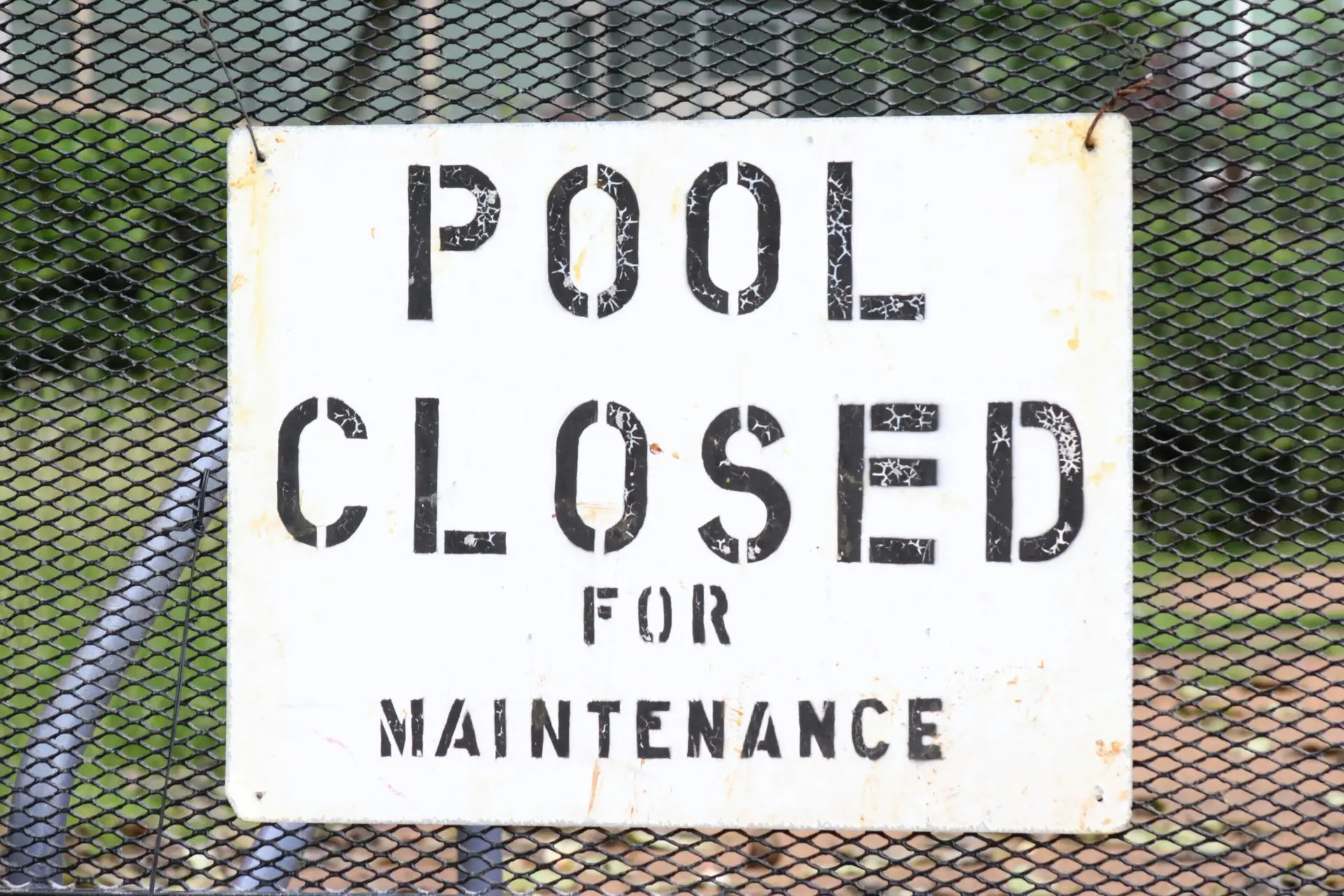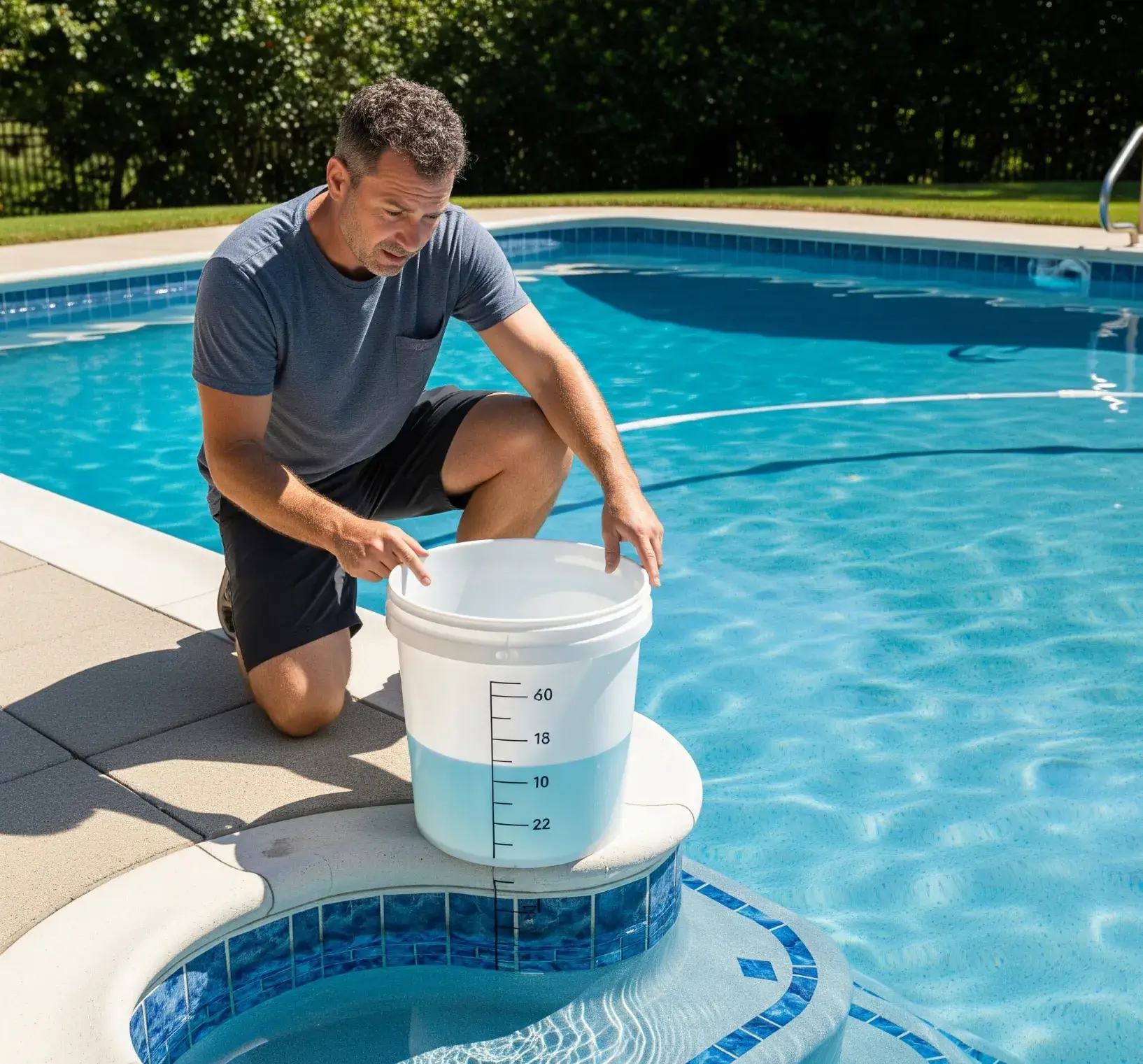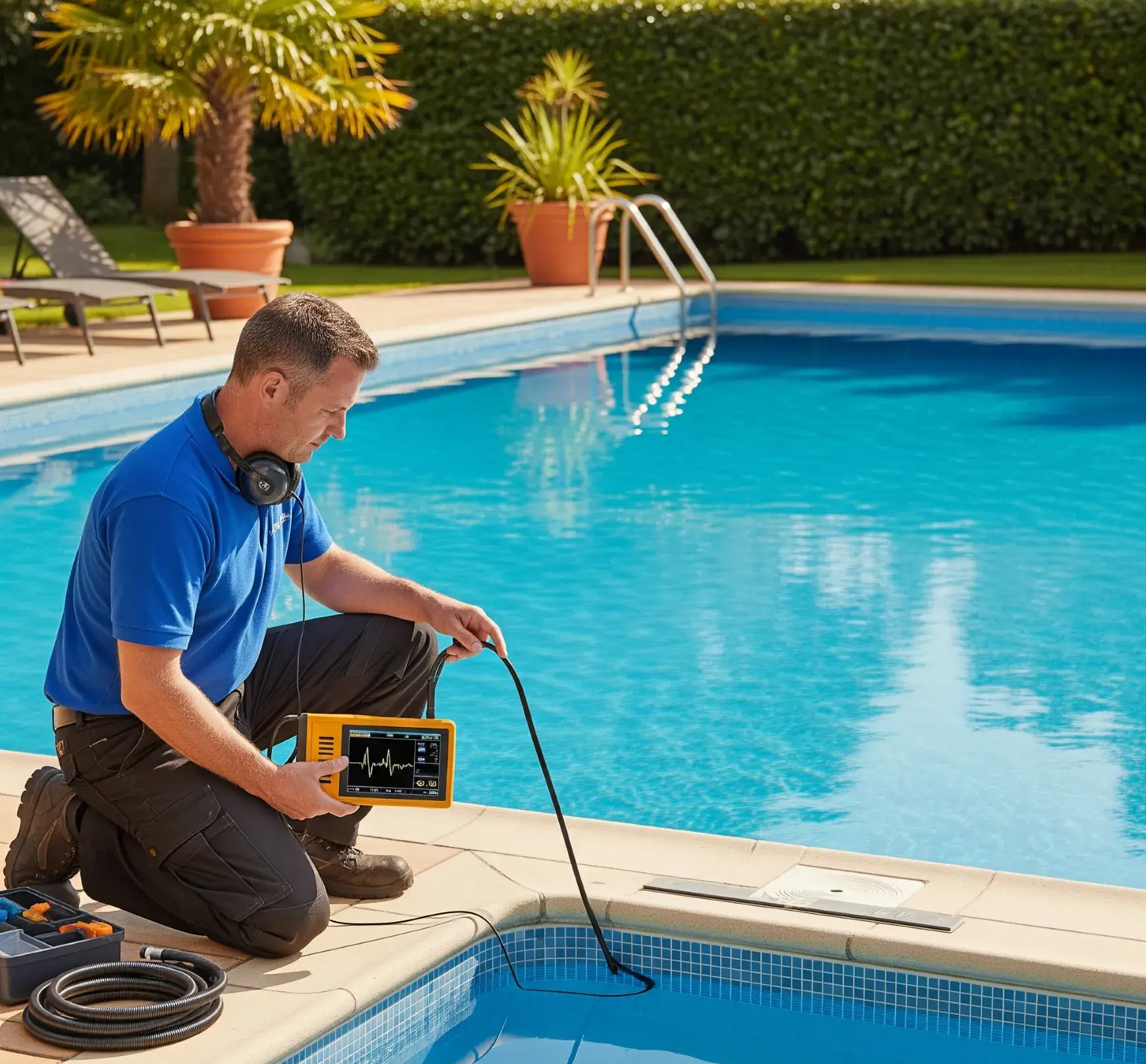Professional Pool Leak Detection in Orange County – DIY & Expert Methods

Losing hundreds of gallons of water each week from an undetected leak can cause serious damage. For homeowners, scheduling professional pool leak detection in Orange County ensures small leaks are caught early before repairs become expensive. In this guide, we’ll explain DIY leak detection methods like the bucket test and dye test, explore advanced technologies such as acoustic sensors and infrared cameras, and show why hiring Sun Coast Pools & Spa gives you the most accurate results.
What Are the Common Signs and Causes of Swimming Pool Leaks?
Swimming pools that lose water rapidly or incur unexpectedly high fill volumes often indicate underlying leaks in the shell or plumbing. Detecting these issues early prevents structural damage and preserves water quality for safer swimming. For example, a sudden drop in water level coupled with soggy ground around the pool can signal a crack in the shell or a failing pipe.
How Can Homeowners Identify Water Loss and High Water Bills?
- Measure the waterline drop each morning after 24 hours to track consistent losses.
- Record water meter usage before and after refilling the pool to quantify gallons lost.
- Compare your utility bills month-to-month to spot unexplained increases in water consumption.
Consistent tracking of both pool levels and meter data provides objective evidence that a leak, rather than wasteful splashing or backwashing, is the culprit—and paves the way for targeted testing.
What Are the Differences Between Evaporation and Actual Pool Leaks?
Distinguishing evaporation from a true leak requires a controlled bucket test. Place a five-gallon bucket on the pool step, fill it to the pool’s waterline, mark inside and outside levels, then run the pump for 24 hours. If the pool loses more than a half-inch while the bucket remains steady, the difference indicates a leak. This simple comparison rules out weather-driven water loss and sharpens focus on leak detection methods.
Which Pool Areas Are Most Prone to Leaks?
- Skimmer throat and gaskets can crack under pressure.
- Main drain fittings sometimes loosen or corrode.
- Return jets and eyeballs may shift, loosening seals.
- Pool lights and equipment unions can develop hairline fractures.
- Vinyl liner seams weaken over time and can tear.
How Do Structural Issues and Plumbing Failures Cause Leaks?
Ground movement, freeze-thaw cycles, and hydrostatic pressure can crack gunite shells or shift plumbing lines beneath the deck. Similarly, corrosion, poor initial installation, and high system pressure can cause pipe joints to fail. Recognizing whether water loss stems from a compromised shell or buried pipe helps determine whether to apply surface-level patches or deploy advanced diagnostic tools in the equipment pad.
DIY Pool Leak Detection Methods for Orange County Homeowners

Homeowners can conduct several low-cost detection methods—bucket test, dye test, visual inspection, and equipment check—to screen for leaks before scheduling professional services. These DIY approaches reveal obvious cracks, discern between evaporation and loss, and identify equipment-area drips, saving time and narrowing down potential problem zones.
Pool Leak Detection Methods
Various methods exist for detecting pool leaks, including visual inspections, bucket tests, and dye tests. These methods help homeowners identify leaks and differentiate between evaporation and actual leaks, guiding them toward appropriate repair strategies.
American Leak Detection, “Pool Leak Detection”
This source provides a general overview of pool leak detection methods, which aligns with the article’s discussion of DIY and professional techniques.
How to Perform the Bucket Test to Detect Water Loss?
Begin by placing a stable plastic bucket on the pool step and filling it to the pool’s waterline.
- Mark the inside water level of the bucket and the outside pool level with waterproof tape.
- Turn off all water features and let the pool sit untouched for 24 hours.
- Compare the drop in the pool waterline with the bucket’s waterline—the greater drop indicates a leak.
This controlled evaporation comparison reliably signals active leakage before investing in advanced methods.
How Does the Dye Test Help Locate Visible Leaks?
A dye test uses colored tracer dye to reveal suction points in the pool shell or liner where water escapes.
- Turn off the pump to eliminate circulation currents.
- Release a drop of dye near suspected cracks or gaps.
- Watch for dye movement toward leaks, drawn into escaping water.
- Mark confirmed leak sites for repair.
By visually tracing flow patterns, homeowners can pinpoint fractures or liner tears that warrant sealing or professional intervention.
What Should You Look for During a Visual Pool Inspection?
- Cracks or gaps in plaster or tile grout.
- Loose or missing pool tiles along the waterline.
- Puddles or soggy ground around skimmers and returns.
- Rust stains that signal corroded metal fittings.
- Algae growth in hidden crevices indicating constant moisture.
Spotting these external symptoms directs focused testing and accelerates repairs.
How to Check Pool Equipment for Possible Leak Sources?
- Look for water collecting under the pump motor or base.
- Observe the skimmer faceplate for air bubbles drawn from a suction leak.
- Check threaded unions in the filter and heater for dampness.
- Monitor drip trays beneath heaters for slow leaks.
Equipment-area leaks often mimic pool shell leaks but can be remedied by re-sealing fittings or replacing gaskets.
Advanced Professional Pool Leak Detection in Orange County

Professional leak detection services employ non-invasive technologies—acoustic sensors, infrared cameras, pressure testing, electronic probes, and tracer gas—that pinpoint leaks beneath pool shells and underground plumbing. These methods deliver precision, reduce excavation, and protect surrounding landscaping from unnecessary disruption.
Professional Leak Detection Techniques
Professional leak detection services utilize advanced technologies such as acoustic sensors, thermal imaging, and pressure testing to pinpoint leaks. These methods offer greater accuracy and can identify leaks that are difficult to find with DIY methods, minimizing the need for extensive excavation.
Pool & Spa News, “Leak Detection: Finding the Source” (2022)
This citation supports the article’s claims about the effectiveness of professional leak detection methods and the benefits of using advanced equipment.
| Method | How It Works | Advantage |
|---|---|---|
| Acoustic Leak Detection | Listens for water escaping under pressure using hydrophones | Locates leaks in buried pipes without digging |
| Thermal Imaging | Identifies temperature anomalies caused by water flow with infrared cameras | Detects hidden leaks through deck and shell |
| Pressure Testing | Applies air or water pressure to isolated plumbing lines to reveal pressure drops | Pinpoints faulty fittings in suction and return lines |
| Electronic Leak Detection | Uses low-voltage electrical currents to locate breaches in vinyl liners or concrete cracks | Finds liner perforations and hairline fractures accurately |
| Tracer Gas Detection | Introduces inert gas into plumbing and detects escape points with a gas sniffer | Discovers tiny leaks in underground plumbing networks |
How Does Acoustic Leak Detection Work to Find Hidden Leaks?
Acoustic leak detection harnesses sensitive microphones to amplify the sound of pressurized water escaping subterranean pipes. Technicians interpret frequency patterns to triangulate leak locations.
- Precision: Locates leaks as small as pinholes.
- Non-invasive: Preserves surrounding landscape.
- Versatile: Effective on PVC, metal, and plastered systems.
How Is Thermal Imaging Used to Detect Temperature Differences?
Thermal imaging cameras detect subtle heat shifts where water flow changes the temperature of surrounding materials.
- Infrared scanning reveals cooler areas where water migrates.
- Wide coverage helps survey large pool shells quickly.
- Safe for hard-to-reach spots without disrupting operations.
What Is Pressure Testing and How Does It Pinpoint Plumbing Leaks?
Pressure testing isolates sections of plumbing—suction lines, return lines, or main drains—by sealing off valves and applying regulated air or water pressure.
- A monitored pressure drop over time signals a leak.
- Marking the affected section guides targeted excavation or repair.
- Prevents unnecessary digging by narrowing down leak zones precisely.
How Do Electronic Leak Detection Systems Identify Breaches?
Electronic leak detection sends low-voltage electrical currents through the water and pool shell to locate discontinuities in vinyl liners or concrete cracks.
- Sensors measure current flow variations at leak sites.
- Versatility spans vinyl liner, fibreglass, and gunite pools.
- Accuracy down to hairline fractures under tiles or finishes.
What Is Tracer Gas Detection and When Is It Used?
Tracer gas detection injects an inert, non-flammable gas—typically helium—into underground plumbing, then employs a gas sniffer along pipe routes to locate escape points.
- Ideal for deep or inaccessible pipes that resist acoustic methods.
- Finds micro-leaks that escape pressure testing.
- Minimally invasive, requiring only small access holes.
Why Are Professional Tools More Accurate Than DIY Methods?
Professional detection equipment outperforms DIY tests by combining sensitive sensors, calibrated instruments, and experienced interpretation.
- Greater precision reduces guesswork and unnecessary excavation.
- Non-destructive diagnostics protect pool finishes and landscaping.
- Faster turnaround minimizes pool downtime.
Where Are the Most Common Pool Leak Locations and How Are They Repaired?
Leaks typically occur where water flows under pressure through fittings or joins the pool structure, and each location demands a specific repair approach. Proper identification followed by targeted sealing, epoxy injections, or component replacement restores integrity and prevents repeat failures.
How to Identify and Repair Skimmer and Main Drain Leaks?
- Identification: Dirt trails or a soggy ground around the skimmer.
- Repair: Remove the skimmer faceplate, reseat or replace the gasket, and apply pool-grade epoxy to any visible cracks.
- Benefit: Restores watertight seal without extensive resurfacing.
What Are the Signs and Fixes for Plumbing Leaks on Suction and Pressure Sides?
- Signs: Bubbles in the skimmer, hissing sounds in the equipment pad, pooling water near fittings.
- Fix: Clamp and pressure-test each section, then replace or re-seal faulty unions and threaded fittings with chemical-resistant sealant.
How Are Vinyl Liner Leaks Detected and Patched?
- Perform an electronic leak detection scan to map perforations.
- Clean and dry the liner surface thoroughly.
- Apply vinyl-patch adhesive and liner patch, smoothing edges for a watertight bond.
Proper patching restores liner integrity and prevents unsightly wrinkles or bulges.
What Causes Concrete Pool Cracks and How Are They Repaired?
- Cause: Structural shifting beneath the shell or poor initial reinforcement.
- Repair: Inject epoxy or polyurethane foam into the crack, then ground flush and refinish to match existing plaster.
How to Detect and Fix Pool Light and Equipment Leaks?
- Inspect the light niche gasket and conduit fittings for moisture.
- Remove the light fixture, replace O-rings, and re-lubricate with silicone grease.
- Tighten or re-seal heater and filter unions using approved thread sealant.
Why Should Homeowners Hire Professional Pool Leak Detection Services?
Hiring professional leak detection services ensures accurate diagnosis using advanced equipment, minimizes invasive excavation, and delivers expert repair recommendations tailored to each pool’s design. This approach saves time, preserves property value, and safeguards against repeat leaks.
What Are the Benefits of Professional Leak Detection Over DIY?
- High accuracy in locating underground or hidden leaks.
- Non-invasive methods that preserve landscaping and finishes.
- Comprehensive reporting with clear findings and repair plans.
- Warranty-backed repairs for peace of mind.
How Is the Cost of Professional Pool Leak Detection Determined?
- Pool size and volume influence testing time.
- Preferred detection methods (acoustic, thermal imaging, tracer gas) carry different equipment costs.
- Accessibility of plumbing and skimmer areas affects labor.
- Geographic location and seasonal demand can also play a role.
What Can Homeowners Expect During a Professional Leak Detection Service?
- Initial inspection of water loss patterns and visual review.
- Targeted testing using one or more advanced detection technologies.
- Detailed report pinpointing leak locations and recommended repairs.
- No-obligation quote for repair options.
How to Choose the Right Pool Leak Detection Company in Southern California?
- Verify licensing and certifications for pool leak detection.
- Seek experience with both residential and commercial pool systems.
- Confirm use of state-of-the-art, non-invasive equipment.
- Read local customer reviews and request case studies from similar projects.
How Can Preventative Pool Maintenance Help Avoid Future Leaks?
Proactive maintenance—routine inspections, water chemistry balance, proper winterization, and scheduled professional checkups—fortifies pool systems against leaks by identifying wear points before they fail. Consistent care extends equipment life, preserves finishes, and prevents sudden water loss crises.
What Routine Inspections Should Homeowners Perform?
- Checking the waterline for drops and marking changes.
- Inspecting all fittings, skimmers, and returns for moisture.
- Monitoring pool chemistry to prevent corrosive pH swings.
- Examining plaster and tile grout for early cracks.
How Does Maintaining Proper Water Chemistry Prevent Leaks?
- Keep pH between 7.2 and 7.6 to protect grout and equipment seals.
- Maintain alkalinity at 80–120 ppm to stabilize pH swings.
- Monitor calcium hardness (200–400 ppm) to prevent aggressive water that dissolves plaster.
Stable chemistry preserves both pool structure and plumbing integrity, reducing stress-related leaks.
What Are Best Practices for Pool Winterization to Protect Against Leaks?
- Lower the water level below skimmers and returns.
- Blow out lines and plug fittings with insulated caps.
- Treat water with winter algaecide and scale inhibitor.
- Cover the pool securely to keep debris and animals out.
These steps help prevent ice formation and ground-shift stresses that crack shells and pipes.
How Does Regular Maintenance Extend Pool Health and Leak Prevention?
A consistent maintenance schedule cultivates early problem detection and system longevity. Seasonal service visits, filter cleanings, and professional inspections reinforce home inspections by catching hidden wear. This layered approach reduces emergency repairs and sustains your pool’s performance for years.
What Are the Most Frequently Asked Questions About Pool Leak Detection?
Homeowners commonly wonder how professionals locate hidden leaks, what early warning signs to watch for, the risks of structural damage, typical detection costs, and the reliability of tests like the bucket test. Understanding these frequent concerns clarifies why combining DIY diagnostics with expert assessments yields the best results and preserves pool health.
Losing water through an undiagnosed leak can escalate repair complexity and utility expenses. Whether you’re testing basic evaporation or deploying infrared cameras, accurate leak detection safeguards your investment. For homeowners in Southern California seeking expert assistance, Suncoast Pool & Spa offers comprehensive service, advanced technology, and transparent pricing to find and fix leaks with minimal disruption. Contact us at suncoastpoolspa.com to schedule your professional pool leak detection and enjoy a worry-free swimming season.
Why Choose Sun Coast Pools & Spa for Pool Leak Detection in Orange County?
When it comes to hidden leaks, our team combines years of experience with cutting-edge technology. From acoustic testing to infrared scanning, we deliver accurate pool leak detection in Orange County that saves water, protects landscaping, and prevents long-term damage.

